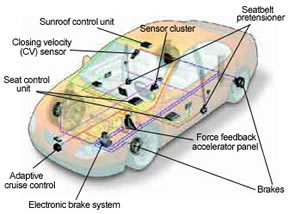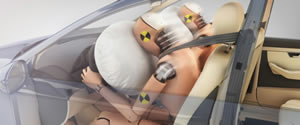Difference between Active and Passive Safety Features on a Vehicle
Key difference: The active safety features are mainly the features that work to prevent the risk of a collision or an accident. These are so named because they are always active, and working to prevent an accident. Passive Safety Features, on the other hand, are systems that are passive until called into action. They become active during the accident and aim to help minimized the damage from the collision.
 As necessary as driving a vehicle is, it also comes with its own set of hazards. Hence, safety features on a vehicle are essential. Cars have been known to be quite versatile; some have even called them death traps referring to the amount of accidents that involve cars. Of course, one may argue that many of these accidents are rarely the fault of the car, but rather the fault of the drivers. Whatever the case, it is true that everybody considers it the job of the cars to protect the drivers, even the reckless ones.
As necessary as driving a vehicle is, it also comes with its own set of hazards. Hence, safety features on a vehicle are essential. Cars have been known to be quite versatile; some have even called them death traps referring to the amount of accidents that involve cars. Of course, one may argue that many of these accidents are rarely the fault of the car, but rather the fault of the drivers. Whatever the case, it is true that everybody considers it the job of the cars to protect the drivers, even the reckless ones.
In order to protect the drivers, car manufactures often implement various safety features in their cars, often touting them as safer than the competitor cars in the process. These safety features are often divided into two categories: Active Safety Features and Passive Safety Features.
The active safety features are mainly the features that work to prevent the risk of a collision or an accident. These are so named because they are always active, and working to prevent an accident. These are often electronic, computer-controlled components that include braking systems, like brake assist, traction control systems and electronic stability control systems, as well as forward-looking, sensor-based systems such as Advanced Driver Assistance Systems including adaptive cruise control and collision warning, avoidance and mitigation systems. These features interpret signals from various sensors in order to help the driver control the vehicle.
 Passive Safety Features, on the other hand, are systems that are passive until called into action. They become active during the accident and aim to help minimized the damage from the collision, and to reduce the risk of injury or death. These systems include seat belts, airbags and strong body structures.
Passive Safety Features, on the other hand, are systems that are passive until called into action. They become active during the accident and aim to help minimized the damage from the collision, and to reduce the risk of injury or death. These systems include seat belts, airbags and strong body structures.
Comparison between Active and Passive Safety Features on a Vehicle:
|
|
Active Safety Features |
Passive Safety Features |
|
Definition |
Active safety systems are systems that are always active. They use an understanding of the state of the vehicle to both avoid and minimize the effects of a crash. |
Passive safety systems are those systems which remain passive until they become active. They become active only when a collision happen |
|
Alternate Name |
Primary Safety, Driver Assistance Systems |
Secondary Safety, Crashworthy Systems |
|
Purpose |
To assist in the prevention of a crash |
To protect occupants during a crash |
|
Active |
active prior to an accident |
active during an accident |
|
Examples |
|
|
Image Courtesy: machinedesign.com, bosch-automotivetechnology.com









Comments
MyCall
Mon, 07/10/2017 - 15:05
Add new comment